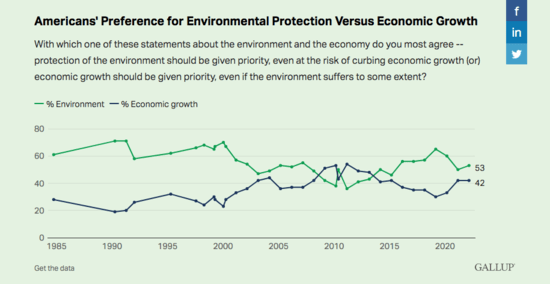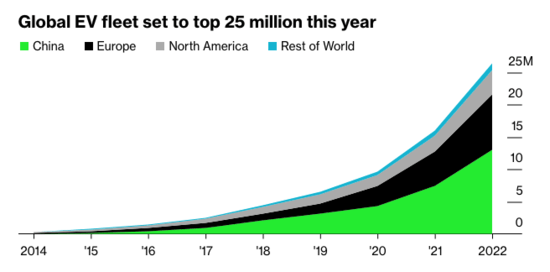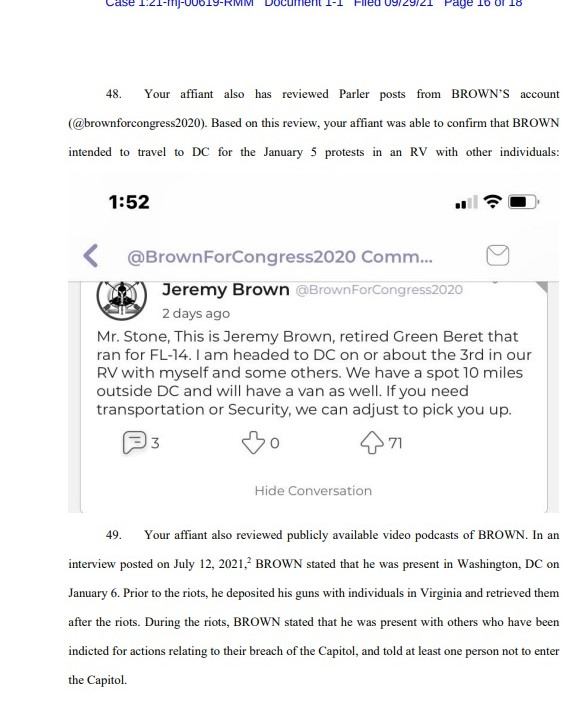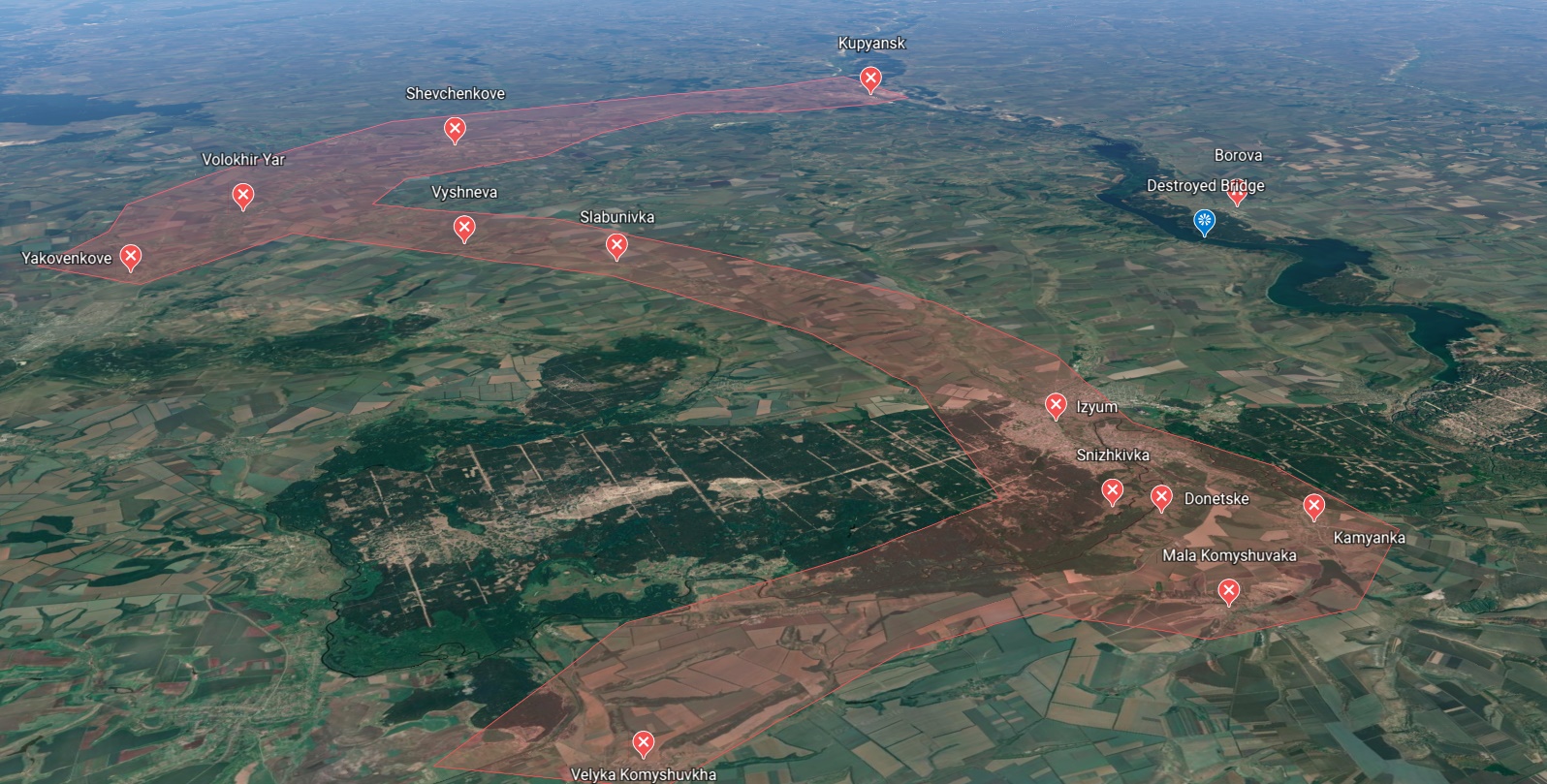Independent News
'Delivering newspapers while Black': Off-duty cop aims gun at delivery man, faces felony charges
This post was originally published on this site
A former Michigan police officer was allowed to hold onto employment with the city of DeWitt after stopping a Black newspaper delivery man while off duty, following him, and pulling a gun on 19-year-old Alexander Hamilton. Chad Vorce was arraigned last Thursday and charged with assault with a dangerous weapon, firearm possession, and misconduct in office, all felonies, according to the office of Michigan Attorney General Dana Nessel. Vorce faces up to five years in prison and a fine of $10,000 for the misconduct charge alone.
But the city he works for, DeWitt, which is about 100 miles west of Detroit, was not able to terminate the officer, and local prosecutors in Clinton County failed to charge him with a crime, according to Fox 47. The state attorney general was instead asked to review the case in January and charged the veteran city employee.
According to the attorney general’s office, the assault charge carries a penalty of up to $2,000 and four years in prison, and the weapons possession charge carries a penalty of two years in prison.
“Our assessment of this incident showed dangerous behavior exhibited by Mr. Vorce,” Nessel said in a statement. “Those who swear to protect and serve must do so responsibly. We will not hesitate to hold accountable those who violate that oath.”
Hamilton’s lawyer Dustyn Coontz told Fox 47 he is seeking the additional charge of felonious assault and two additional felonies related to firearm possession. “I think the AG’s office is under-charging Vorce compared to how my clients are frequently charges,” Coontz told the news station.
He also filed a civil suit against Vorce and the city of DeWitt.
“The wrong-doing is obvious here, right?” Coontz told Fox 47. “We had a grown man, who happens to be a police officer, pull a gun on a teenager for delivering newspapers while Black. We are saying that that’s assault—which the Attorney General’s Office agrees, they’re saying that’s assault by a dangerous weapon—but we’re also saying that the city of DeWitt ought to bear some responsibility here.”
Vorce was not on duty when he spotted Hamilton around 7:15 a.m. on Jan. 14, 2021, in Watertown Township, Coontz stated in the suit. The community is nearly 90% white and 2.2% Black, according to U.S. Census data. At the time of the encounter between Hamilton and the police officer, Vorce, also a volunteer firefighter, was on his way to take his son to school in a personal truck fitted with emergency lights, and Hamilton was delivering the Lansing State Journal in a minivan, Coontz stated in the suit.
Vorce reportedly asked Hamilton what he was up to, and although Hamilton responded, “I’m just doing me,” Vorce called the Clinton County Central Dispatch. The top line of the office’s report reads: “BLK MALE IN THE AREA JUST DOING ME NEEDS CHECKED,” Coontz wrote in the suit.
He also stated that Vorce, an officer with the DeWitt Township Police Department for approximately 18 years, had mentioned theft-related crimes in the area. Still, instead of waiting for authorities to arrive, Vorce followed Hamilton, according to the suit.
“When Vorce pulled behind Hamilton, Hamilton tried to back up to ask what was going on, but Vorce also backed up,” Coontz stated in the suit.
“Hamilton, wary of Vorce’s activity, drove away to get out of the neighborhood and onto the much busier Airport Road.
“Vorce continued to follow him.”
At one point, Vorce alleged that Hamilton was trying to ram into him, and Vorce told a dispatcher that he was “going to go shots fired” if Hamilton did it again, according to the lawsuit.
When Hamilton made a U-turn heading back to the neighborhood on his paper delivery route, Vorce again claimed Hamilton was trying to ram him, according to the suit. “At this point, Vorce got out of his car and pulled his pistol on Hamilton,” Coontz wrote in the suit. “Vorce identified himself as police with his gun drawn.”
According to the suit:
40. It’s unclear if this was a police-issued firearm or his personal firearm.
41. Hamilton again turned his van around and drove away.
42. Vorce got back in his car and followed Hamilton, telling dispatch that this was now a priority call and that things would “turn out really bad” if help didn’t arrive quickly.43. Hamilton, fearing for his life, decided to drive somewhere public to hopefully deter violence on Vorce’s part.
44. Vorce followed Hamilton to the Sunoco (AKA Tailgaters) at 3955Ernest Way, which is in DeWitt Charter Township, Clinton County,Michigan.
45. To try to get Hamilton to stop, Vorce turned on at least his“wigwagging” headlights in his truck, and possibly his overhead emergency light too.
46. Hamilton, scared, did a few laps around the gas pumps before coming to a stop.
47. When he did, Vorce got out of his truck screaming profanities at Hamilton.
48. Amidst the profanities, he again identified himself as a police officer.
49. Vorce was wearing a reflective DeWitt Fire Department jacket.
50. Vorce again pulled his gun, looking Hamilton in the eye and aiming no higher.
Vorce didn’t fire at Hamilton, and soon after, Officer Clyde Smith, of the DeWitt Police Department, arrived although the incident happened outside of his jurisdiction, Coontz stated in the suit.
”Hamilton was unarmed, and there was no individualized articulable suspicion to indicate otherwise,” Coontz wrote in the suit. “Despite this, Smith removed Hamilton from his van and arrested him under, citing the possibility that Hamilton committed assault with a dangerous weapon by trying to ram Vorce.”
Michigan State Police Trooper Luke Shafer later arrived and after talking to two sergeants, agreed there was no basis to arrest Hamilton, according to the suit.
“After a while, Vorce indicated that he did not want to press charges after all, and Smith and Shafer allowed Hamilton and Vorce to leave,” Coontz stated in the suit. “Hamilton was handcuffed for roughly 38 minutes before being released.”
Hamilton is seeking punitive damages and asking that Vorce “be enjoined from serving as a law enforcement officer until the day he dies.”
The city of DeWitt fired Vorce months after the incident for “operating outside of his jurisdiction, using excessive force, failing to de-escalate the situation, having an inappropriate tone and demeanor, and violating the department’s social media policy,” according to records obtained by the Lansing State Journal. But an arbitrator decided to reinstate Vorce in December, writing that Vorce’s actions didn’t undermine or “significantly” impair the police department’s “good reputation.”
Yet here I am writing about it, and here renowned civil rights attorney Ben Crump is condemning Vorce’s behavior in a tweet liked more than 4,800 times.
The DeWitt city administrator did not immediately respond to Daily Kos’ request for comment.
Trump's going all in to trash frontrunner Brian Kemp in Georgia's GOP gubernatorial primary
This post was originally published on this site
Georgia Republican Gov. Brian Kemp is trouncing his Trump-backed primary opponent in both cash and polling, but Donald Trump just can’t let it go.
Kemp, of course, refused to illegally overturn the state’s thrice-counted 2020 results and, for Trump, that’s a betrayal worth investing in.
So Trump is doing something highly unusual—dipping into his own campaign funds to malign Kemp and give his lackluster endorsee, former Sen. David Perdue, a boost.
Ahead of the May 24 primary, Trump’s Save America PAC has transferred a sizable sum of $500,000 to another PAC that’s solely focused on ousting Gov. Kemp from office, according to Politico.
It’s a special gesture for a special vendetta, and the very first time Trump has reached into his $110 million war chest to make a substantial donation to another candidate. Let’s face it, Trump doesn’t part ways with money easily, but he clearly harbors an abiding white-hot hate for Kemp.
Listen and subscribe to Daily Kos Elections’ The Downballot podcast with David Nir and David Beard
The effort is likely a fool’s errand—a perfect fit for Trump. Kemp maintains a nearly double-digit lead over Perdue and, as of Jan. 31, Kemp reported having $12.7 million in his war chest to Perdue’s $1 million cash on hand. Last month, the Kemp camp promised to spend north of $4 million in ad buys prior to the late-May primary.
Frankly, all of this is outstanding news for Democrats. Shortly after Trump’s cash infusion, the anti-Kemp Super PAC Get Georgia Right cut an ad saying Kemp “dismissed concerns” about 2020 voter fraud. “If Kemp can’t beat voter fraud, he won’t beat [Democratic candidate] Stacey Abrams,” the ad charged.
The TV spot is being disseminated in the state’s most conservative areas in a bid to turn out die-hard Trump voters at the polls.
Given the current mismatch, it’s entirely plausible that Kemp will still prevail next month. But even if Kemp survives the onslaught, Trump’s fan base will likely walk away with a sour taste in its mouth. To this day, Trump believes Kemp committed the gravest of sins, and there’s a good chance that mindset has also embedded itself in the hearts of his cultists.
Just last weekend at a Fulton County GOP meeting, Kemp endured a round of heckling from pro-Trumpers peppering him with 2020 election conspiracy theories. The Atlanta Journal-Constitution’s Greg Bluestein caught the action.
“I’m the governor. I’m not a dictator,” Kemp said, pushing back on the criticism. “All the issues that you’re talking about, you need to talk to the Secretary of State about,” he added, throwing Republican SOS Brad Raffensperger under the bus.
Eventually, Kemp got testy, questioning where all his critics had been when he was serving as Secretary of State and battling Stacey Abrams in the run up to the 2018 gubernatorial race.
“I fought them every single time when none of these naysayers over here even cared about it,” he said. “Now they’re trying to blame me for something that I had no constitutional authority to do.”
One heckler responded, “Liar.” Others belted out, “Special session,” presumably referring to the post-election legislative session Trump allies had lobbied the governor to call in order to overturn the results.
At that point, Kemp decided to cut his losses.
“If you want to know what the truth is about the election, you should first relearn what the laws and the Constitution say,” he said, just before thanking the crowd and making a quick exit.
Kemp also had a strong contingent of supporters at the event, but the room was divided, and that division holds promise for Democrats.
Kemp effectively telling his detractors that they’re stupid and they should reeducate themselves on the law was just icing on the cake. Nothing could help Democrats more in November than a dispirited and depressed Trump base.
You tell ‘em, Kemp—bravo.
Listen and subscribe to Daily Kos’ The Brief podcast with Markos Moulitsas and Kerry Eleveld
Earth Matters: Group will monitor Biden's eco-justice promises; U.S. majority backs climate action
This post was originally published on this site
Three long-time environmental justice activists announced at the Historically Black Colleges and Universities’ Climate Change Conference in New Orleans Tuesday that they have secured funding to hold the Biden administration accountable for its commitment to the Justice40 initiative the president announced as part of an executive order his first day in office.
The initiative mandates that at least 40% of federal climate investments go directly to communities most affected by poverty and pollution. One of the three, Peggy Shepard, executive director of New York environmental justice group We Act for Environmental Justice, said at a virtual news conference, “I have not met many elected officials in my state or in many others who have ever heard of it.”
The other two activists are Beverly Wright of the Deep South Center for Environmental Justice and Robert Bullard of the Bullard Center for Environmental and Climate Justice. Bullard is widely known as the “father of environmental justice.”
All three, with Shepard as chairwoman, serve on the White House Environmental Justice Advisory Council. And while they are critical of the administration’s efforts, they aren’t hostile, noting that it’s too early to fully judge results. Bullard told reporters he gives the administration a “passing” grade so far. Wright said, “As a college professor, at this point, I grade them an incomplete.” That, in part, reflects the fact that the administration is still trying to determine which communities need investment most.
Drew Costley reports that Wright and Bullard said previous federal social and infrastructure projects have failed disadvantaged communities and they don’t want to see it happen again. “There’s been a lot of really novel approaches at changing the lives of Americans in general” but that just benefited white Americans, Wright said. As an example, Bullard pointed to discrimination in how flood relief was distributed in Texas after recent hurricanes there.
The trio’s initiative—called Engage, Enlighten and Empower—is being underwritten with $14 million from the Bezos Earth Fund.
Listen and subscribe to Daily Kos’ The Brief podcast with Markos Moulitsas and Kerry Eleveld
How to Get Involved This Earth Day
ECOQUOTE
“Climate activists are sometimes portrayed as dangerous radicals. But the truly dangerous radicals are the countries that are increasing production of fossil fuels. Investing in new fossil fuel infrastructure is moral and economic madness.” —António Guterres, UN Secretary-General
SHORT TAKES
Climate Change Proposals Favored by Solid Majorities in U.S.
The Gallup organization published its annual environment poll Monday. It gauges public sentiment for six policies meant to prevent or ameliorate the impacts of the climate crisis. By wide margins, Americans favor the policies, but there is a considerable difference across the political spectrum. Support, Gallup said, “ranges from 59% in favor of spending federal money for building more electric vehicle charging stations in the U.S. up to 89% for providing tax credits to Americans who install clean energy systems in their homes.”

When it comes to whether the environment or the economy should be given priority, the chart below shows that favoring the environment has lost ground, especially during the Great Recession a dozen years ago. The fact that the environment and the economy aren’t separate entities but inextricably intertwined fails to get through to many people.

The World’s Electric Vehicle Fleet Will Soon Surpass 20 Million
In 2016, there were only 1 million electric vehicles (EVs) on the planet’s roads. Come June, it’s projected that we’ll pass the 20 million mark and at the current rate of sales, 26 million by year’s end. China (with nearly half the total sales) and Europe are driving this adoption hardest, with North America a distant third. In the second half of the year, nearly a million new EVs a month will be added to these numbers, according to BNEF estimates—one every 3 seconds. This ramp-up far exceeds expectations of legacy vehicle and oil companies just a few years ago. As Kevin McKarracher reports, in BP’s 2016 outlook, the company estimated some 71 million plug-in vehicles would be on the road by 2035. BNEF puts the crossing of that milestone in 2025, a decade ahead of schedule. Still, there is a long, long way to go in converting the world to EVs. There are currently an estimated 1.2 billion light passenger vehicles powered by internal combustion engines globally, making that 20 million figure less than 2% of the total.

In ‘Scientist Rebellion,’ Researchers Face Arrest for Climate Action
A growing number of scientists around the world are stepping out of their labs and onto the streets to demand greater action to curb global warming, some even risking arrest as they chain themselves to banks and other institutions that they say aren’t taking the climate crisis seriously enough. As rising greenhouse gas emissions continue to drive up sea levels and exacerbate storms, wildfires and droughts, it’s putting increasing pressure on the scientific community to depart from its typical role as a neutral information provider and pick up the torch of activism.
Last week, an estimated 1,000 scientists in more than 25 countries staged demonstrations to demand that world leaders do far more to reduce climate-warming emissions, including a handful of researchers who were arrested for locking themselves to the gate of the White House and to the front door of the JPMorgan Chase bank in Los Angeles, as well as blocking traffic on the I-395 highway in Washington, D.C. […]
The events were part of a growing movement dubbed the “Scientist Rebellion,” a coalition of researchers around the world who seek to “expose the reality and severity of the climate and ecological emergency by engaging in non-violent civil disobedience.”
Critics will argue that by taking such action, these protesting scientists aren’t being objective. On the contrary, they are taking action because they’re objective and know where we’re headed if we don’t come up with the political will to seriously tackle the climate emergency.
green tweet
ECOPINION
We could all use some good news right now. By Peter Dykstra at Environmental Health News. Environmental headlines can be bleak, but good news is out there, too. “The environmental beat can be a real downer and we often focus on the problems—but there are signs of progress in our fight against climate change and pollution. From renewable projects to plastic treaties, here are some dashes of hope for our planet.”

Autocracies and Fossil Fuels Go Hand in Hand. By Bill McKibben at The Nation. The extraction of hydrocarbons tends to support despotism, whereas sun and wind are much closer to being democratic. [A]s I wandered the halls and the streets outside [at the COP26 Glasgow climate summit in November], it struck me again and again that a good deal had changed since the last big climate confab in Paris in 2015—and not just because carbon levels and the temperature had risen ever higher. The biggest shift was in the political climate. Over those few years the world seemed to have swerved sharply away from democracy and toward autocracy—and in the process dramatically limited our ability to fight the climate crisis. Oligarchs of many kinds had grabbed power and were using it to uphold the status quo; there was a Potemkin quality to the whole gathering, as if everyone was reciting a script that no longer reflected the actual politics of the planet. Now that we’ve watched Russia launch an oil-fired invasion of Ukraine, it’s a little easier to see this trend in high relief—but Putin is far from the only case.
Democrats Need to Fix Rural Economies—and Get the Credit for It. By Nick Hanauer at The American Prospect. “The American economy continued to expand throughout the neoliberal era, but nearly all of the benefits of this growth accrued to a relatively small number of big cities and their surrounding counties, a trend that only appears to be accelerating. At the median, rural workers now earn only 82 cents on every dollar earned by their urban counterparts, and as rural jobs grow more scarce and less diverse, rural workers have fewer opportunities to close the gap. Nationally, the U.S. workforce grew by 68% since 1975 while rural employment actually shrank by nearly a third. Between 2007 and 2018, just 11% of counties captured 9 out of every ten new jobs, a massive concentration of employment and wage growth in a handful of deep-blue metros. In second-tier cities, small towns, and rural counties, the health, and well-being of residents are being left behind.”

Op-ed: Fake Meat Won’t Solve the Climate Crisis. By Philip H. Howard at Civil Eats. “When you’re told there’s a simple solution to a very complex problem, you’re probably not getting the whole story. Today’s meat consumption is a good example. Meat and dairy are increasingly under the world’s microscope as livestock—which rely on huge quantities of feed crops and occupy nearly 80% of global farmland—accounts for between 14% and 30% of global greenhouse gas (GHG) emissions. It’s also the source of more frequent antimicrobial-resistant pathogens, and much of the global livestock and seafood industries have been exposed for unsafe and abusive working conditions. This complex web of problems requires more than one answer. And yet ‘alternative proteins’—from plant-based to lab-grown ‘fake’ meat and dairy—are being promoted as a simple solution.”
Nationalize the U.S. Fossil Fuel Industry to Save the Planet. By Robert Pollin at The American Prospect. Turning the biggest oil companies over to public ownership would serve several goals at once, including climate resilience.
The world’s most ambitious climate goal is essentially out of reach. By Shannon Osaka at Grist. Why won’t anyone admit it? “For the world to have even a sliver of a chance to meet its goals under the Paris Agreement, the scientists warned, emissions must peak no later than 2025 and then enter a precipitously steep decline. But hidden on page 25 of the “Summary for Policymakers” was an even grimmer note: That even in the IPCC’s most optimistic models, the chances of holding global warming to less than 1.5 degrees Celsius (2.7 degrees Fahrenheit) — compared to the pre-industrial average—is only around 38%. In short, even if countries were to defy their history of delay and act heroically quickly to boost clean energy, the odds are that it won’t be enough. For all intents and purposes, the 1.5-degree threshold has already passed. We just don’t know it yet.”
The Privatization of Water Is a Threat to Global Health. By Beauty Dhlamini at Jacobin. Water is a basic resource for all human beings. Yet market forces are increasingly privatizing water provision — not only making water unaffordable to poor and working-class people but posing a serious threat to public health in the midst of the pandemic.
WEEKLY ECOVIDEO
HALF A DOZEN OTHER THINGS TO READ (or LISTEN TO)
What Humans Can Learn From Nature’s Biggest Hibernators. By Chris Woolston at The Atlantic. Could bears hold the key to better treatments for stroke, osteoporosis, and Alzheimer’s? The roster of animals that hibernate includes all manner of rodents, some amphibians, and even a few primates (several species of dwarf lemurs), but bears are literally the biggest hibernators of them all. Adult grizzly and black bears outweigh even the largest American football players, and have the energy and curiosity of preschoolers, but they have no trouble hunkering down for months at a time. The choreography that goes into shutting down a creature this big defies easy explanation, says Elena Gracheva, a neurophysiologist at Yale University, in New Haven, Connecticut. “Hibernation is so complex, it requires adaptations at multiple levels,” she says. Bear hibernation offers important insights into the workings of large mammals, especially us, explains Gracheva, who co-authored an exploration of the physiology of hibernation in the 2020 Annual Review of Cell and Developmental Biology. A better understanding of the process could potentially change our approach to a wide range of human conditions, including stroke, osteoporosis, Parkinson’s disease, and Alzheimer’s.
Somalia drought: ‘Act now or 350,000 children will die’. By Mercy Juma at the BBC. “If nothing is done, it is projected that by the summer of this year, 350,000 of the 1.4 million severely malnourished children in the country, will perish,” warns Adam Abdelmoula from the United Nations Office for the Coordination of Humanitarian Affairs (Ocha). “Already in this country, 70% of school-age children are not attending school. In just one state in Juba land, the drought has led to closure of 40 schools and that is going to be the trend in many drought-affected areas,” he continues, adding that some girls are being married off early because their families cannot feed them.

Global biodiversity is in crisis, but how bad is it? It’s complicated. By Elizabeth Claire Alberts at Mongabay. Biodiversity has been defined as one of nine planetary boundaries that help regulate the planet’s operating system. But humanity is crossing those boundaries, threatening life on Earth. The big question: Where precisely is the threshold of environmental change that biodiversity can withstand before it is destabilized and collapses planetwide? The planetary boundary for biodiversity loss was initially measured by extinction rates, but this, as well as other measurements, have proved to be insufficient in determining a global threshold for biodiversity loss. At present, a worldwide threshold for biodiversity loss—or biosphere integrity, as it is known now—remains undetermined. However, thresholds for biodiversity loss can be clearly defined at local or regional levels when an ecosystem goes through a regime shift, abruptly changing from one stable state to another, resulting in drastic changes to biodiversity in the changed ecosystem.
The insect crisis: where did all the bugs go? (Podcast) Insects are a crucial part of our way of life. They are experts in pollination, pest control, and decomposing corpses, and yet humans don’t seem to spend a lot of time thinking about them. But with populations in decline due to habitat loss, pesticides, and the climate crisis, what would our world look like without them? Scientists are warning that we ignore these animals at our peril. In recent decades they have detected a stark drop in the number of insects. Michael Safi speaks to the environment reporter Oliver Milman, author of The Insect Crisis: The Fall of the Tiny Empires that Run the World, about the fascinating world of insects. Oliver tells Michael how these tiny creatures, often dismissed as an annoyance, play a vital role in making the Earth habitable.

Shrinking the Economy to Save the World By Kyle Paoletta at The Nation. The degrowth movement argues that the only way toward an ecologically sustainable world it to redirect economies away from market imperatives. Fifty years ago, fears ran rampant that the “population bomb” announced by biologists Paul and Anne Ehrlich would produce a world without enough space to feed its untold billions of inhabitants. Now it’s a population “bust” we must prevent, what political scientist Darrell Bricker and journalist John Ibbitson describe as “a relentless, generation-after-generation culling of the human herd” in their 2019 manifesto Empty Planet. […]For many economists, the coming demographic apocalypse is a problem only insofar as it will damage the gross domestic product. Though the GDP does not speak in any meaningful way to people’s actual quality of life, it remains an obsession of policy-makers around the world, who accept the premise that a growing GDP is a sign of a healthy economy and that a rising population is a key component of that equation.
Microplastics Found Deep in the Lungs of Humans for the First Time. By Damian Carrington at Mother Jones. What this means for our health is unknown—but it can’t be good. The scientists said microplastic pollution was now ubiquitous across the planet, making human exposure unavoidable and meaning “there is an increasing concern regarding the hazards” to health. […] Microplastics were detected in human blood for the first time in March, showing the particles can travel around the body and may lodge in organs. The impact on health is as yet unknown. But researchers are concerned as microplastics cause damage to human cells in the laboratory and air pollution particles are already known to enter the body and cause millions of early deaths a year.
ECOBITS
• ExxonMobil Announces $10 Billion Oil Investment the Same Day IPCC Signals End for Fossil Fuels • Methane emissions soar to highest level ever recorded • “Black carbon” threat to Arctic as sea routes open up with global heating • Chile announces unprecedented plan to ration water as drought enters 13th year • Colorado’s First Legally Composted Human Remains Laid to Rest • Could a Transportation Revolution Actually Save Us From Climate Change? • War Gives Oil Producers Greater Clout at Global Climate Talks • Great Plains Farmers Push Back Against CO2 Pipelines Encroaching on Their Land • ‘Forever chemicals’ upended a Maine farm — and point to larger problem • What Humans Can Learn From Nature’s Biggest Hibernators
Oath Keeper who wanted to give Roger Stone a ride on Jan. 6 faces heap of new charges
This post was originally published on this site
Things just got a whole lot tougher for Jeremy Brown, a former special-ops soldier in the U.S. Army and self-proclaimed Oath Keeper, who was already facing charges tied to his alleged involvement in the riots at the U.S. Capitol on January 6.
Brown now faces nine new charges from the Department of Justice. They come atop two existing counts that the 47-year-old has faced since October when he was charged with entering a restricted building and disorderly conduct. Prosecutors say Brown was marauding dangerously close to an area where Vice President Mike Pence would or could have been passing through.
The new allegations filed in a superseding indictment on Tuesday include possession of unregistered explosive grenades, an unregistered shotgun, 8,000 rounds of ammunition, and a Palmetto Armory rifle. Other counts are tied to illegal storage of the explosive materials and in four new charges, the DOJ also accused Brown—who once held Secret security clearance—of “unauthorized possession and control over documents relating to the national defense” in his Florida home.
Superseding Jeremy Brown Indictment April 12 2022 by Daily Kos on Scribd
On Jan. 6, 2021, prosecutors say Brown sported full military gear, replete with tactical vest, radio, helmet, and zip ties, and carried large surgical trauma shears tucked into his vest as he marched on the Capitol.
He had been planning his trip to Washington since December. This, at least, is what someone described only as “Defendant 4” in court records told authorities after pleading guilty to obstructing an official proceeding on Jan. 6.
“Defendant 4” said they met Brown at Brown’s home two days before the assault but they had been chatting over Signal, an encrypted app, for weeks about their impending January rendezvous.
Brown also didn’t appear to hide his plans. For instance, on the right-wing social media app, Parler, under the account “@BrownforCongress2020” (Brown had led a failed congressional bid), he appeared to address Roger Stone, the longtime GOP fink and strategist who pumped Trump’s lies about fraud in the 2020 election.
“Mr. Stone, This is Jeremy Brown, retired Green Beret that ran for FL-14. I am headed to DC on or about the 3rd in our RV with myself and some others. We have a spot 10 miles outside DC and will have a van as well. If you need transportation or security, we can adjust to pick you up.”

RELATED STORY: Documentary featuring Roger Stone is an embarrassment of riches for Jan. 6 probe
Planning out checkpoints and rest stops before finally entering D.C. on Jan. 4., the text messages obtained by prosecutors show Brown anticipating that at least two days would be necessary to get “EVERYTHING ready once we arrive.”
He lovingly dubbed his RV “Ground Force One.”
“We have an RV [and] Van going. Plenty of Gun Ports left to fill. We can pick you up,” he allegedly wrote in a message on Jan. 1.

In a podcast in June 2021, while talking about being in D.C. on Jan. 6 and attending the Stop the Steal rally at the Ellipse, Brown admitted to being involved with the Oath Keepers after the November election and opined about the group being infiltrated. Brown also claimed two federal agents knocked on his door the following month and asked him about his political pro-Trump social media rants.
In one of those rants, Brown suggested he left guns in Virginia before the riots.
That sounds similar to what other Oath Keepers, like Edward Vallejo and ringleader Elmer Rhodes, allegedly orchestrated in a seditious conspiracy to stop the peaceful transfer of power on Jan. 6. Vallejo, according to his indictment, took orders from Rhodes but oversaw and coordinated weapons caches at a hotel in Virginia.
RELATED STORY: Proud Boys fold like cheap suit, Oath Keepers raked by judge on way to trial
On the podcast, Brown also said that he was with people who went into the building but he did not go inside.
FBI agents say they spoke to Brown by phone on Jan. 6 and again on Jan. 7. The call on the Jan. 6 was short. He sounded like he was in a crowd. When agents contacted him the next day. Brown admitted to being at the rally on Jan. 6 and even said he was “providing security to VIPS at the ‘Stop the Steal’ rally.”
Prosecutors say on the afternoon of Jan. 6, Brown was 100 feet past barriers erected by police. As cops barked at rioters trying to retake a line thinly secured by law enforcement, Brown would not retreat until batons were brought out.
Agents said he was yelling at the police about how they were the ones violating the Constitution.
According to a statement found on his phone, when the riots were over, Brown wrote:
“Everything you are watching on the Media and the Houses of Congress is a LIE! I was shot in the neck with pepper balls and beating in the forearm with a night stick trying to shield unprotected Civilians from being hit in the head. This was an exercise in unrestrained addiction to power.”
Tuesday’s new charges don’t offer much insight about any of the allegedly classified information law enforcement found at his home in Tampa, though the documents do not appear to be directly related to Jan. 6 in any way.
They included threat frequency reports on explosives from Afghanistan in 2004, IED reports from 2005, spider device testing procedures from 2004, and fragmentary orders from 2005.
An attorney for Brown could not immediately be reached Thursday. Brown has remained in detention since his arrest last fall.
The Tampa Bay Times reported in October that authorities found $6,000 cash at Brown’s Florida home when they arrested him as well as a list of items he would need to live off the grid.
Brown will be arraigned on the superseding indictment on April 21 before U.S. Magistrate Judge Sean Flynn.
The last time Brown appeared before Flynn, the judge reportedly wrestled with the decision to keep him detained but Brown had made threats against law enforcement.
He slapped together a handwritten sign and planted it in front of his home. Addressing the FBI, Homeland Security, and the local sheriff’s office, the sign called them “pawns” and warned them if they returned they would “need a bigger tactical package” to take him away.
Ukraine update: Blowing up the bridge at Borova
This post was originally published on this site
On Wednesday, the Ukrainian government circulated images of a destroyed bridge somewhere in the Donbas region—a bridge that had been taken down by Ukrainian special forces. Not only was the bridge itself destroyed, it was taken down as a Russian convoy was passing over, destroying four large trucks and a Tigr-M (sort of the Russian equivalent of a Humvee).
In the hours following the images’ release, most attention focused on the loss of the vehicles in the convoy and the idea that Ukrainian special forces were able to slip through Russian lines to strike a target in an area of Russian control. But as it became clear just which bridge this was, the importance of this strike—and how it plays into the greater story of what’s happening in eastern Ukraine—becomes far more obvious.

This is the bridge in question. It spans the broad Oskil Reservoir between the town of Borova on the eastern bank, and the village of Bakhtyn on the west. Before the invasion, both areas would have been under Ukrainian control. It’s about 50 miles north of Russian-occupied areas in Luhansk oblast. But Russian forces moved swiftly up the eastern side of the Oskol River during the first days of the invasion, and Borova has been nominally in their pocket for some time, though this area between the river and the P66 highway about a dozen miles to east has remained in dispute.
What makes this bridge so important becomes somewhat obvious when you see it in slightly broader context.

The pinkish area in this image represents roughly the outline of that “Izyum salient” — the extension of Russian forces south of Kharkiv that has allowed Russia to pile up armor and men at sites around the recently captured town of Izyum. Russia would like to push this salient south or west, allowing them to cut off a big chunk of eastern Ukraine and trap Ukrainian troops located along the defensive lines to the east. Originally, it seemed like Russia intended to continue south toward Slavyanka or Kramatorsk (which was risky). More recent reports have indicated Russia intends to push west for Dnipro (which seems suicidal).
But no matter which way Russia moves, it clearly has to keep its supply lines open. Right now, that line pokes into disputed territory at Kupyansk and cuts west to Volokhir Yar before turning south along the M03 highway. This is a long and complex route. It’s also subject to be sliced in half by Ukrainian forces moving south from Kharkiv. It’s not a good way to begin a move that has to stretch for another 100 miles or more and be sustained in the field for weeks.
What would help? A shorter route. One that could act as both a bonus and an alternative in case that Volokhir Yar crossroads falls. Something like … that bridge west of Borova.
With that bridge, Russia had an alternative means of bringing in supplies that not only made the trip to Izyum shorter on the west side of the Oskil, but meant that the start of the salient would be much closer to their long-held area in Luhansk than the current starting point at Kupyansk. It would cut miles off their route in both directions, and make the whole salient more sustainable. Which is, without a doubt, why Ukraine thought it was worthwhile to get in there and take that bridge out.
Of course, there is a possibility that Russia could simply work around it. Here are a couple of images of the area south of Izyum. First, an image of the area just southwest of the city from Google Earth that is just over a year old:

That dark line is, of course, the river that flowed around the south half of Izyum and kept Russia from taking all of the city for several weeks. Now, here’s a low-resolution version of some imagery from Maxar Technologies that was taken just a week ago.

The second image is a lot browner, because things are only starting to green up in the area. However, that’s not the critical difference I want to point out. The big difference is actually something quite small. Do you see it? About one-third of the way over from the left there’s a light band running down to the river. And over the river itself, there’s a thin line. That line is a pontoon bridge. And that broad band of lighter color shows where a large number of Russian vehicles crossed the bottomlands, then drove across that quickly erected bridge to connect to a small road on the south side of the river. That’s what allowed them to get around the town’s defenders and eventually take the city—reportedly with the help of someone who helped them locate this low water crossing.
Russia could definitely do something similar to the east of Izyum. They could create a pontoon bridge across the Oskol river, likely somewhere south of Borova. Or they could cross the existing bridge at the town of Oskil, which is very close to Izyum and and an even shorter distance from Russian-held territory. Except … Russia doesn’t seem to have been able to bring forces across that bridge. In the latest low-res imagery, that bridge appears to be possibly damaged near the east shore. Also, it’s even close to those defensive positions Ukraine occupies on the eastern border than it is to Russian-occupied territory. Finally, it’s also a long trip through disputed areas for forces entering Ukraine near Kharkiv.
It was always clear that, no matter which way Russia wanted to move in its effort to grab the Donbas region, that effort would run through Izyum. It’s a good bet that Russia never would have gone all the way up to Kupyansk if it could have moved forces down effectively through the bridge at Oskil. Maybe the bridge is down. Maybe there’s too much Ukrainian opposition in the area. Whatever the reason, Kupyansk was where they went first, and Borova was what they tried to capture to both increase the flow of supplies and provide a backup.
Which is something Russian forces might sorely miss … when they are forced to retreat.

Georgia governor signs bill protecting farms from suits filed by neighbors, environmental groups
This post was originally published on this site
Georgia Gov. Brian Kemp signed a bill Wednesday making it a lot easier for farms to get away with funking up the environment and forcing residents to live with noxious smells or polluted water.
HB 1150, titled “Freedom to Farm,” essentially limits the time in which a neighbor of a farm can sue to two years. Lawsuits could come in the form of noise or smell complaints, or any other problems caused by a farm, industrial processing plant, or slaughterhouse.
The bill amends a previous one that gave residents four years max to sue over issues related to a nearby farm.
The bill additionally blocks any non-neighbors, such as an environmental nonprofit organization, from suing a farm, as reported by the Atlanta Journal-Constitution (AJC).
RELATED STORY: Stacey Abrams turns tables on Gov. Kemp, files suit to use law he signed for himself in her favor
Critics of the bill include at least one farmer who said she had no issues with the previous laws.
“We want to be good stewards of the land. And for the most part, especially in Gordon County, that’s been happening,” Charlotte Swancy, a Gordon County farmer said during a hearing for the bill in February. “But in our county, there was a proposal of bringing in a 150 chicken house operation. And under the current bill, we still have protection to litigate against something like that.”
House Agriculture and Consumer Affairs Committee Chairman Robert Dickey III, one of the bill’s seven all-Republican sponsors, claimed during the hearing in February that the bill was “just trying to give farmers some protection to farm their land like they’ve always done it, when you have some neighbors who might move in and have a little different opinion.”
In a written statement to AJC, April Lipscomb, an attorney for the Southern Environmental Law Center, explained why she thought the amended bill would hurt residents living near the farms.
“Under current law, residents who were there first can protect their property rights any time an agricultural nuisance occurs, even if the nuisance occurs 20 years after the agricultural facility began operating,” she wrote. “Under HB 1150, existing residents can only protect their property rights from nuisances created during the first two years of the facility’s operation. That is not a compromise; it’s an assault on property rights.”
Agriculture is Georgia’s leading industry, bringing in more than $74 billion to the state annually and leading the nation with its production of peanuts, eggs, and broilers (chickens), as well as cotton, pecans, blueberries, and more.
The bill was endorsed by the Georgia Farm Bureau, the Georgia Agribusiness Council, the Georgia Poultry Federation, and the Georgia Forestry Association, The Moultrie Observer reports.
Kemp used Russia’s invasion of Ukraine to justify why signing this bill was so important.
“As the global marketplace continues to react to Russia’s unprovoked and unjust war in Ukraine—Europe’s breadbasket—the importance of the ag sector here in America, and especially here in Georgia, will only continue to grow. Our farming families are more important than ever, and that’s one of many reasons why it’s so crucial we protect their way of life.”
Trump screwed up in the last debates, so the Republican Party just announced they're killing them
This post was originally published on this site
As previously signaled, the Republican National Committee is now vowing it won’t be letting its candidates participate in the presidential debates traditionally organized by the Commission on Presidential Debates. This was announced in a suitably blustery tweet by sedition supporter Ronna McDaniel, a tweet in which McDaniel says the party will “find newer, better debate platforms” so that their candidates will not have their fee-fees hurt by the “biased” commission:
HA HA HA HA—sorry, sorry. Ahem.
Well, we can take “newer, better debate platforms” to mean they’re going to find the griftiest grift out there, demanding that all the candidates “debate” on Trump’s rickety new “social network,” or from within a fort made entirely of MyPillows, or on whatever “platform” happens to be most favored by white supremacist groups when debate season next rolls around.
Mostly, however, this is a telegraphed move meant to protect Donald Trump, because four years of Trumpian purges have turned the Republican National Committee into a group that protects the interests of Donald Trump and only Donald Trump, and Donald Trump has no intention of debating anyone. The RNC has been telegraphing such a move for a long, long time, and they’ve done so while parroting Trump’s own paranoia-laced language about the debate commission being “biased” and “unfair” to him.
He didn’t like the questions he was asked the last time around, he didn’t like moderators challenging him, and he got into a particular spat when he showed up with a likely active case of COVID-19 for a debate with Joe Biden and refused to be tested. Trump was hospitalized shortly afterward with a raging COVID case, but pulled through, going on to kill hundreds of thousands more Americans before eventually ending his term with an attempted coup. There, you’re caught up.
So this move is being made exclusively because Donald Trump again intends to run for the presidency. Donald Trump has already signaled that he won’t be debating this time around, so the RNC needs to invent some justification for why he’ll be doing so that’s a bit more creative than “because he’s a tremendous damn coward.” That doesn’t solve the other problem, however, which is making sure none of the other presidential contenders upstage Donald by attending debates themselves.
So the RNC is taking care of that one, too. Also as previously expected, the RNC has also voted to require Republican presidential candidates to sign a pledge to only appear at party-approved debates. Those who break their vow by debating in a non-approved venue will be sanctioned by being removed from any future party-sanctioned debates, presuming the party ever bothers to sanction any.
To translate, the Republican National Committee, which has been purged of anyone who does not hew mercilessly to Donald Trump’s personal whims and announced fantasies, is saying that they will be boycotting the traditional presidential debates and that all the non-Donald Trump candidates are hereby barred from debating each other in any venue that Trump’s party allies haven’t personally given their permission for.
Wow, that sounds like a rather amazing boon for … Donald Trump. And it effectively gives Trump veto power over every debate format and venue, because anything he personally refuses to participate in will be marked down as “unapproved” by RNC heads so as to protect him from looking bad. Or, at least, to protect him from looking even worse.
All of that said, this announcement isn’t worth much. It can be undone at the drop of a hat, and if something happens that prevents Treasonboy from seeking office again, the new rules will become whatever the new frontrunner wants them to be. For the moment, however, this is a big, big thumb on the scales for Trump and against Mike Pence (who will never, ever be the party nominee no matter how much he imagines it) and Florida Gov. Ron DeSantis (who has been quickly morphing into Donald Trump by copying both his gestures and his paranoias, and would likely become the frontrunner if Donald Trump fell down a Florida sinkhole while golfing and couldn’t be fished out.)
This is what you get with a cult of personality: a party with no platform, no ideology other than whatever Dear Leader last tweeted, and new rules adjusted however they need to be in order to make Dear Leader a slightly less embarrassing figure when possible. Donald can’t stand confrontation and especially doesn’t want anyone talking about the long, long list of things he screwed up or corrupted during his first term, so the party is going to make everybody else sign a pledge promising they’ll only attend “debates” with moderators hand-picked to ensure those things don’t come up.
RELATED STORIES:
Trump hated the debates—so the Republican Party is now barring their candidates from appearing
Trump’s 2020 debate humiliations are fodder for the latest Republican attacks on democratic norms
Our path forward with renewables must be an environmentally just one
This post was originally published on this site
Working towards net-zero is not without its complications—especially when it comes to making sure history doesn’t repeat itself. Countless vulnerable communities bear the brunt of the worst consequences from big polluters in the fossil fuel industry. Everything from air to soil can be compromised from mining, drilling, refining, and more. Just as communities worry when major companies bring in such damaging practices for oil and gas, they’re also concerned about the tools needed for battery storage, electric vehicle production, and renewable energy generation. A recent Mother Jones feature encapsulates this struggle, highlighting the battle between copper mining company Resolution Copper and the Indigenous community of the San Carlos Apache Indian Reservation in Arizona.
Resolution Copper—which has a parent company, Rio Tinto, with a history of violating worker and Indigenous rights—plans to build a copper mine in an area around Lake Superior that includes portions of Tonto National Forest, including the sacred Oak Flat site known to the San Carlos Apache tribe as Chi’chil Bildagoteel. The mesa is considered a blessed place that has been a site of worship and has held significance for the tribe since time immemorial. It’s also said to have enough copper to potentially meet a quarter of the United States’ renewables needs. Though the site has been protected as public land since 1955 and has been on the National Register of Historic Places since 2016, Resolution Copper and other interested parties have worked to undermine those protections in a bid to start mining as soon as possible.
Mother Jones points out a land swap bill that was tucked into a 2014 defense spending measure allowing Resolution Copper to trade acreage from a different location in Arizona in order to access Oak Flat for its mining operation. That bill came at the behest of John McCain and Jeff Flake, both of whom have benefitted from Rio Tinto’s largesse, with McCain receiving campaign donations from affiliated parties and Flake at one point even lobbying for Rio Tinto. Moving forward with the mine has been overwhelmingly unpopular with Arizonans, however. Last year, 74% of voters said they opposed the project, crossing party lines and staying consistent in both urban and rural communities.
Listen and subscribe to Daily Kos’ The Brief podcast with Markos Moulitsas and Kerry Eleveld
This isn’t the only project that could jumpstart our green future but faces pushback over environmental concerns: Rural Nevada communities last year slammed a solar project they say could harm the environment, concerns abound when it comes to hydrogen hub and carbon capture projects across the country, and communities in Idaho worry that reopening a gold mine could lead to environmental disaster, though gold has been used to jumpstart solar panel efficiency. Throughout these stories, there is the common thread of vulnerable communities facing the threat of projects that could alter their very ways of life.
The Biden administration has vowed to center environmental justice, having unveiled an equity agenda that includes a promise to “ensure that environmental justice is at the heart of the [Environmental Protection Agency’s] mission.” But advocates say that promise is not enough. According to E&E News, We Act for Environmental Justice Executive Director Peggy Shepard; Deep South Center for Environmental Justice Executive Director Beverly Wright; and the father of environmental justice, Robert Bullard, have joined forces to better hold the federal government accountable. With support from the Bezos Earth Fund, the trio will oversee developments in the Biden administration’s promise to invest 40% of climate-related benefits into communities impacted by environmental racism.
In the meantime, projects like the Resolution Copper mine remain in limbo. A lawsuit filed by Apache Stronghold, a nonprofit committed to defending Indigenous holy sites, seeks to prevent the land transfer that would grant Resolution Copper access to Oak Flat from taking effect. Mother Jones states that a decision from the Ninth Circuit Court of Appeals could be made “any day.” The most recent activity regarding the case occurred April 5, when appellees on the U.S. side filed what’s known as a “citation of supplemental authorities,” essentially adding a citation to a point made by Apache Stronghold; in this case, quibbling about how the destruction of sacred Indigenous land “does not impose a substantial burden.”
Florida Gov. Ron DeSantis signs 15-week abortion ban into law without exceptions for rape or incest
This post was originally published on this site
Advocates are calling today a dark day in Florida. Making Florida the latest to restrict abortion access, Gov. Ron DeSantis signed a bill that bans most abortions after 15 weeks. The move comes two days after Oklahoma’s governor signed a bill that would make performing an abortion a felony in cases that do not risk a woman’s life.
”House Bill 5 protects babies in the womb who have beating hearts, who can move, who can taste, who can see, and who can feel pain,” DeSantis said in a statement Wednesday. “Life is a sacred gift worthy of our protection, and I am proud to sign this great piece of legislation which represents the most significant protections for life in the state’s modern history.”
Florida’s new law, which takes effects July 1, replaces a previous ban that allowed abortions until 24 weeks. It does not make exceptions for incest, rape, or human trafficking.
“As a woman it is my right to make decisions about my body and what is in the best interest of my family,” Rep. Robin Bartleman, a Democrat, said earlier this year, according to NBC News. “God forbid your 11-year-old is raped and pregnant and you find out after 15 weeks, you don’t get to get your daughter that abortion, that’s what this law says.”
Similar to Oklahoma, it does allow abortion in the case of saving a pregnant person’s life or preventing serious injury to them. Fetal abnormalities are also an exception; however, in those cases, at least two doctors must confirm the baby would die shortly after birth for the abortion to happen.
Listen and subscribe to Daily Kos Elections’ The Downballot podcast with David Nir and David Beard
Modeled after the Mississippi law that is making its way to the Supreme Court in an attempt to reverse Roe v. Wade, Florida’s abortion law was passed by the House in February.
The Mississippi Supreme Court decision could reverse the landmark Roe case and impact abortion rights nationally. GOP states across the country are moving quickly to pass laws as it makes its way to the Supreme Court. Alongside Florida, Kentucky voted Wednesday to override Democratic Gov. Andy Beshear’s veto of a bill that bans abortions after 15 weeks of pregnancy with no exceptions for rape or incest, effective immediately.
Various advocacy groups including Planned Parenthood have warned that marginalized communities, including Black and Latino residents, will be impacted most.
“We’ve entered a dangerous time for Floridians’ reproductive freedom. In just a few months, thousands of pregnant people in Florida will no longer be able to access the care they need without leaving their state,” Planned Parenthood President Alexis McGill Johnson said in a statement. “The supporters of this bill have put their own political ambitions and beliefs before the health and futures of their constituents.”
As our very own Jen Hayden sums it up: “Women need federal protection. Congress must act.”
Starbucks keeps trying to crush its workers with union-busting campaign, but it's not working
This post was originally published on this site
Starbucks workers just keep winning. Back in December, two stores going union out of three that voted in Buffalo was a big deal, and the wins were narrow and hard-fought. This week, the union won four votes in a row—unanimously. There was literally no number of votes Starbucks could challenge at those stores (short of every single one) that would have yielded anything but a union. Those votes came at two Boston-area Starbucks, one in Pittsburgh, and one in Eugene, Oregon.
The company isn’t giving up on its anti-union campaign, though. Starbucks has started handing out fliers with fake tweets attributed to @SBWorkersUnited, the union Twitter account. And it has continued firing union leaders. Late Wednesday, More Perfect Union tweeted that the National Labor Relations Board (NLRB) had filed a complaint against Starbucks for mistreatment of two workers in Phoenix, Arizona.
RELATED STORY: Starbucks CEO whines that companies are being ‘assaulted … by the threat of unionization’
One of the Phoenix workers is 19-year-old shift supervisor Laila Dalton, who was repeatedly berated and harassed before being fired. The other is Tyler Gillette, who is autistic and had been promised some reasonable accommodations. Instead, Starbucks put Gillette on indefinite unpaid leave after the union effort went public.
Another worker in Phoenix, Alyssa Sanchez, was told she could shift her schedule from five days a week to four so that she could attend flight school—until managers learned about her support of the union effort, at which point she was put on the schedule five days a week and pressured to resign. An earlier NLRB complaint, which also addresses the treatment of Dalton, called on the company to reinstate Sanchez.
The list of obviously retaliatory firings goes on. In the Buffalo area, shift supervisor Angel Krempa was fired after a series of disciplinary actions that started when she started wearing union paraphernalia, and culminated with her firing for supposedly not calling the store to report that she would be late because of car trouble. Except her phone logs show she did call.
In Raleigh, North Carolina, an organizing committee member was fired after part of a sink fell on her while she was washing dishes.
“The sink just kind of fell off the wall onto me,” Sharon Gilman told VICE. “I wasn’t injured, but it did fall off and I was holding it up and there was water spraying.” Another worker confirmed that Gilman called for help and seemed scared, and workers documented the damage with photographs. The incident happened in February, but it was more than a month later when Starbucks fired Gilman, accusing her of intentionally breaking the sink and claiming to have video showing her yanking on it. Other workers at the store say equipment malfunctions are common there.
Just coincidentally no doubt, Gilman was fired the week ballots were going out for the union vote in her store, after two years on the job with no write-ups.
Starbucks has clearly decided that the cost of illegally harassing and firing workers in retaliation for their union activity is worth it—and no wonder, since the only penalty the company will face is reinstating workers with back pay, minus whatever they have earned at another job while fired. As a tool for making other workers think twice about union support, that’s a lot cheaper than high-priced union-busting lawyers and consultants. But the thing is, it’s obviously not working. They’re firing pro-union workers left and right and this week saw four unanimous votes in favor of unionizing.
Twenty Starbucks stores have unionized, and well over 100 more have filed for union representation elections. That’s a tiny number in the context of the 9,000 or so Starbucks stores out there. But the winning streak here cannot be disregarded—and the company’s union-busting campaign shows it takes the effort very seriously.
RELATED STORY:
Starbucks workers are racking up win after win after win, despite vicious anti-union campaign



